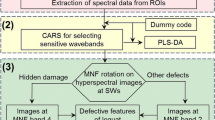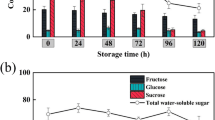Abstract
Mechanical bruise and fungi contamination are two typical defective features for strawberries, resulting in quick quality deterioration of the strawberries during transportation and storage. In this work, the approach of combined image processing with spectra analysis was successfully developed to identify defective strawberries (bruised and fungal infected) using hyperspectral reflectance imaging system. Hyperspectral image data was exploited by minimum noise fraction (MNF) transformation for strawberry defects distinguished by combining thresholding and morphology procedures, and defective regions were located and separated for spectra extracting. The linkages between quality parameters and spectra features were established based on the target defective regions of the fruit. After spectra normalization, three different spectral regions (400 to 600 nm, 650 to 720 nm, and 900 to 1010 nm) were identified for healthy, bruised, or infected strawberries, and eight optimal wavelengths were selected by the successive projection algorithms (SPA) from the whole range of wavelengths. Both linear and non-linear algorithms were developed to identify defective types in strawberries. The results indicated that based on full wavelengths, SVM model performed the highest overall identification accuracy, with the accuracy of 96.91% for calibration and 92.59% for prediction of the fruit. This work shows that hyperspectral reflectance imaging technology has the potential for identifying defective strawberries and provides theoretical basis for the development of online classification of different defected fruits.






Similar content being viewed by others
References
Adak N, Heybeli N, Ertekin C (2016) Infrared drying of strawberry. Food Chem 219:109–116. https://doi.org/10.1016/j.foodchem.2016.09.103
Afrin S, Gasparrini M, Forbes-Hernandez TY, Reboredo-Rodriguez P, Mezzetti B, Varela-Lopez A, Giampieri F, Battino M (2016) Promising health benefits of the strawberry: a focus on clinical studies. J Agric Food Chem 64(22):4435–4449. https://doi.org/10.1021/acs.jafc.6b00857
Andersen CM, Bro R (2010) Variable selection in regression—a tutorial. J Chemom 24(11–12):728–737. https://doi.org/10.1002/cem.1360
Ariana DP, Lu R (2010) Hyperspectral waveband selection for internal defect detection of pickling cucumbers and whole pickles. Comput Electron Agric 74(1):137–144. https://doi.org/10.1016/j.compag.2010.07.008
Büning-Pfaue H (2003) Analysis of water in food by near infrared spectroscopy. Food Chem 82(1):107–115. https://doi.org/10.1016/S0308-8146(02)00583-6
Cen H, He Y, Huang M (2007) Combination and comparison of multivariate analysis for the identification of orange varieties using visible and near infrared reflectance spectroscopy. Eur Food Res Technol 225(5):699–705. https://doi.org/10.1007/s00217-006-0470-2
Cen H, Lu R, Zhu Q, Mendoza F (2016) Nondestructive detection of chilling injury in cucumber fruit using hyperspectral imaging with feature selection and supervised classification. Postharvest Biol Technol 111:352–361. https://doi.org/10.1016/j.postharvbio.2015.09.027
Cheng JH, Sun DW (2017) Partial least squares regression (plsr) applied to nir and hsi spectral data modeling to predict chemical properties of fish muscle. Food Eng Rev 9(1):36–49. https://doi.org/10.1007/s12393-016-9147-1
Cho BK, Kim MS, Baek IS, Kim DY, Lee WH, Kim J, Bae H, Kim YS (2013) Detection of cuticle defects on cherry tomatoes using hyperspectral fluorescence imagery. Postharvest Biol Technol 76:40–49. https://doi.org/10.1016/j.postharvbio.2012.09.002
Elmasry G, Wang N, Elsayed A, Ngadi M (2007) Hyperspectral imaging for nondestructive determination of some quality attributes for strawberry. J Food Eng 81(1):98–107. https://doi.org/10.1016/j.jfoodeng.2006.10.016
Elmasry G, Wang N, Vigneault C, Qiao J, Elsayed A (2008) Early detection of apple bruises on different background colors using hyperspectral imaging. LWT Food Sci Technol 41(2):337–345. https://doi.org/10.1016/j.lwt.2007.02.022
Essghaier B, Fardeau ML, Cayol JL, Hajlaoui MR, Boudabous A, Jijakli H, SadfiZouaoui N (2009) Biological control of grey mould in strawberry fruits by halophilic bacteria. J Appl Microbiol 106(3):833e846. https://doi.org/10.1111/j.1365-2672.2008.04053.x
Folch-Fortuny A, Prats-Montalbán JM, Cubero S, Blasco J, Ferrer A (2016) Vis/nir hyperspectral imaging and n-way pls-da models for detection of decay lesions in citrus fruits. Chemom Intell Lab Syst 156:241–248. https://doi.org/10.1016/j.chemolab. 2016.05.005
Galvão RKH, Araujo MCU, José GE, Pontes MJC, Silva EC, Saldanha TCB (2005) A method for calibration and validation subset partitioning. Talanta 67(4):736–740. https://doi.org/10.1016/j.talanta.2005.03.025
Giusti MM, Wrolstad RE (2001) Characterization and measurement of anthocyanins by UV‐visible spectroscopy. In: Current Protocols in Food Analytical Chemistry, John Wiley & Sons, Inc, pp 143–167
Green AA, Berman M, Switzer P, Craig MD (1988) A transformation for ordering multispectral data in terms of image quality with implications for noise removal. IEEE Trans Geosci Remote Sens 26(1):65–74. https://doi.org/10.1109/36.3001
He Y (2016) Spectroscopy and imaging technology in agriculture. The Science Publishing Company, Beijing
Huang M, He Y, Cen H, Zhu D (2008) Rapeseed nitrogen status estimation of Vis-NIR spectra based on partial least square and BP neural network. IEEE International Conference on Control and Automation, Guangzhou, pp 1799–1803. https://doi.org/10.1109/ICCA.2007.4376671
Keresztes JC, Diels E, Goodarzi M, Nguyen-Do-Trong N, Goos P, Nicolai B, Saeys W (2017) Glare based apple sorting and iterative algorithm for bruise region detection using shortwave infrared hyperspectral imaging. Postharvest Biol Technol 130:103–115. https://doi.org/10.1016/j.postharvbio.2017.04.005
Li XL, He Y (2010) Evaluation of least squares support vector machine regression and other multivariate calibrations in determination of internal attributes of tea beverages. Food Bioprocess Technol 3(5):651–661. https://doi.org/10.1007/s11947-008-0101-y
Li J, Rao X, Ying Y (2011) Detection of common defects on oranges using hyperspectral reflectance imaging. Comput Electron Agric 78(1):38–48. https://doi.org/10.1016/j.compag.2011.05.010
Lopes DS, Escribanobailón MT, Pérez Alonso JJ, Rivasgonzalo JC, Santosbuelga C (2007) Anthocyanin pigments in strawberry. LWT- Food Sci Technol 40(2):374–382. https://doi.org/10.1016/j.lwt.2005.09.018
Mehl PM, Chen YR, Kim MS, Chan DE (2004) Development of hyperspectral imaging technique for the detection of apple surface defects and contaminations. J Food Eng 61(1):67–81. https://doi.org/10.1016/S0260-8774(03)00188-2
Mireei SA (2010) Nondestructive determination of effective parameters on maturity of Mozafati and Shahani date fruits by NIR spectroscopy technique. PhD diss. University of Tehran, Department of Mechanical Engineering of Agricultural Machinery, Persian, Iran
Nabigol A, Morshedi H (2011) Evaluation of the antifungal activity of the Iranian thyme essential oils on the postharvest pathogens of strawberry fruits. Afr J Biotechnol 10(48):9864–9869. https://doi.org/10.5897/AJB10.2018
Nagata M, Tallada JG, Kobayashi T (2010) Bruise detection using nir hyperspectral imaging for strawberry (fragaria * ananassa duch.) Environ Control Biol 44(4):245–255. https://doi.org/10.2525/ecb.44.133
Pan L, Zhang Q, Zhang W, Sun Y, Hu P, Tu K (2016) Detection of cold injury in peaches by hyperspectral reflectance imaging and artificial neural network. Food Chem 192:134–141. https://doi.org/10.1016/j.foodchem.2015.06.106
Pan L, Sun Y, Xiao H, Gu X, Hu P, Wei Y, Tu K (2017) Hyperspectral imaging with different illumination patterns for the hollowness classification of white radish. Postharvest Biol Technol 126:40–49. https://doi.org/10.1016/j.postharvbio.2016.12.006
Shao Y, Bao Y, He Y (2011) Visible/near-infrared spectra for linear and nonlinear calibrations: a case to predict soluble solids contents and pH value in peach. Food Bioprocess Technol 4(8):1376–1383. https://doi.org/10.1007/s11947-009-0227-6
Shen CY, Jin SZ (2013) Principles of optics. Tsinghua University Press, Beijing
Sun Y, Gu X, Sun K, Hu H, Xu M, Wang Z, Tu K, Pan L (2016) Hyperspectral reflectance imaging combined with chemometrics and successive projections algorithm for chilling injury classification in peaches. LWT Food Sci Technol 75:557–564. https://doi.org/10.1016/j.lwt.2016.10.006
Wold JP, Jakobsen T, Krane L (1996) Atlantic salmon average fat content estimated by near-infrared transmittance spectroscopy. J Food Sci 61(1):74–77. https://doi.org/10.1111/j.1365-2621.1996.tb14728.x
Wu D, Sun DW (2013) Hyperspectral imaging technology: A nondestructive tool for food quality and safety evaluation and inspection. In: Yanniotis S, Taoukis P, Stoforos N, Karathanos V (eds) Advances in food process engineering research and applications. Food engineering series. Springer, Boston, pp. 581–606. https://doi.org/10.1007/978-1-4614-7906-2_2
Yu KQ, Zhao YR, Liu ZY, Li XL, Liu F, He Y (2014) Application of visible and near-infrared hyperspectral imaging for detection of defective features in loquat. Food Bioprocess Technol 7(11):3077–3087. https://doi.org/10.1007/s11947-014-1357-z
Yu J, Li C, Takeda F (2016) Nondestructive detection and quantification of blueberry bruising using near-infrared (NIR) hyperspectral reflectance imaging. Sci Rep 6(1):35679. https://doi.org/10.1038/srep35679
Zhang C, Guo C, Liu F, Kong W, He Y, Lou B (2016) Hyperspectral imaging analysis for ripeness evaluation of strawberry with support vector machine. J Food Eng 179:11–18. https://doi.org/10.1016/j.jfoodeng.2016.01.002
Zhao Y, Tu K, Shao X, Jing W, Su Z (2008) Effects of the yeast pichia guilliermondii against rhizopus nigricans on tomato fruit. Postharvest Biol Technol 49(1):113–120. https://doi.org/10.1016/j.postharvbio.2008.01.001
Zhou R, Su S, Yan L, Li Y (2007) Effect of transport vibration levels on mechanical damage and physiological responses of huanghua pears (pyrus pyrifolia nakai,cv. huanghua). Postharvest Biol Technol 46(46):20–28. https://doi.org/10.1016/j.postharvbio.2007.04.006
Acknowledgements
This work was financially supported by the National Natural Science Foundation of China (31671925) and the Priority Academic Program Development of Jiangsu Higher Education Institutions (PAPD), and 2017 graduate students’ innovation project in Jiangsu province (2017-1520).
Author information
Authors and Affiliations
Corresponding author
Ethics declarations
Conflict of Interest
Qiang Liu declares that he has no conflict of interest. Ke Sun declares that he has no conflict of interest. Jing Peng declares that she has no conflict of interest. Mengke Xing declares that she has no conflict of interest. Leiqing Pan declares that he has no conflict of interest. Kang Tu declares that he has no conflict of interest.
Ethical Approval
This article does not contain any studies with human participants or animals performed by any of the authors.
Informed Consent
Not applicable.
Electronic supplementary material
Fig. S1
Loading plot of the PLS-DA models. (a) full wavelengths; (b) selected wavelengths. (Lv = latent variable) (JPEG 399 kb)
Fig. S2
Optimization grid results for SVM models. (a) full wavelengths; (b) selected wavelengths. (Black label ‘X’ stands for selected parameters; the number on contours = misclassification ratio; yellow color □ = 1 (100% misclassification); red color □ = 0 (0% misclassification)) (JPEG 564 kb)
Rights and permissions
About this article
Cite this article
Liu, Q., Sun, K., Peng, J. et al. Identification of Bruise and Fungi Contamination in Strawberries Using Hyperspectral Imaging Technology and Multivariate Analysis. Food Anal. Methods 11, 1518–1527 (2018). https://doi.org/10.1007/s12161-017-1136-3
Received:
Accepted:
Published:
Issue Date:
DOI: https://doi.org/10.1007/s12161-017-1136-3




